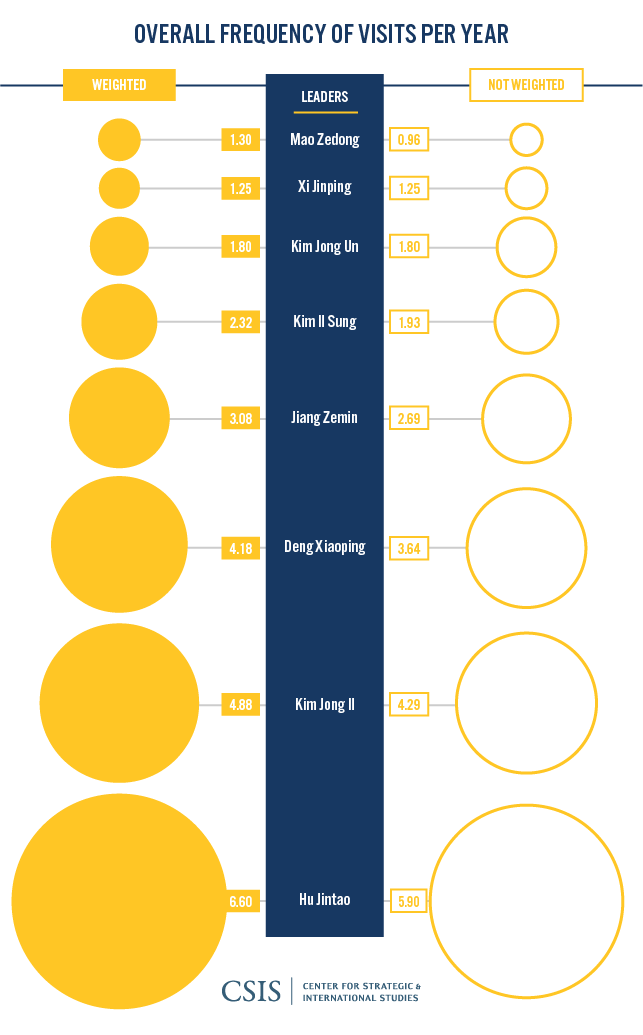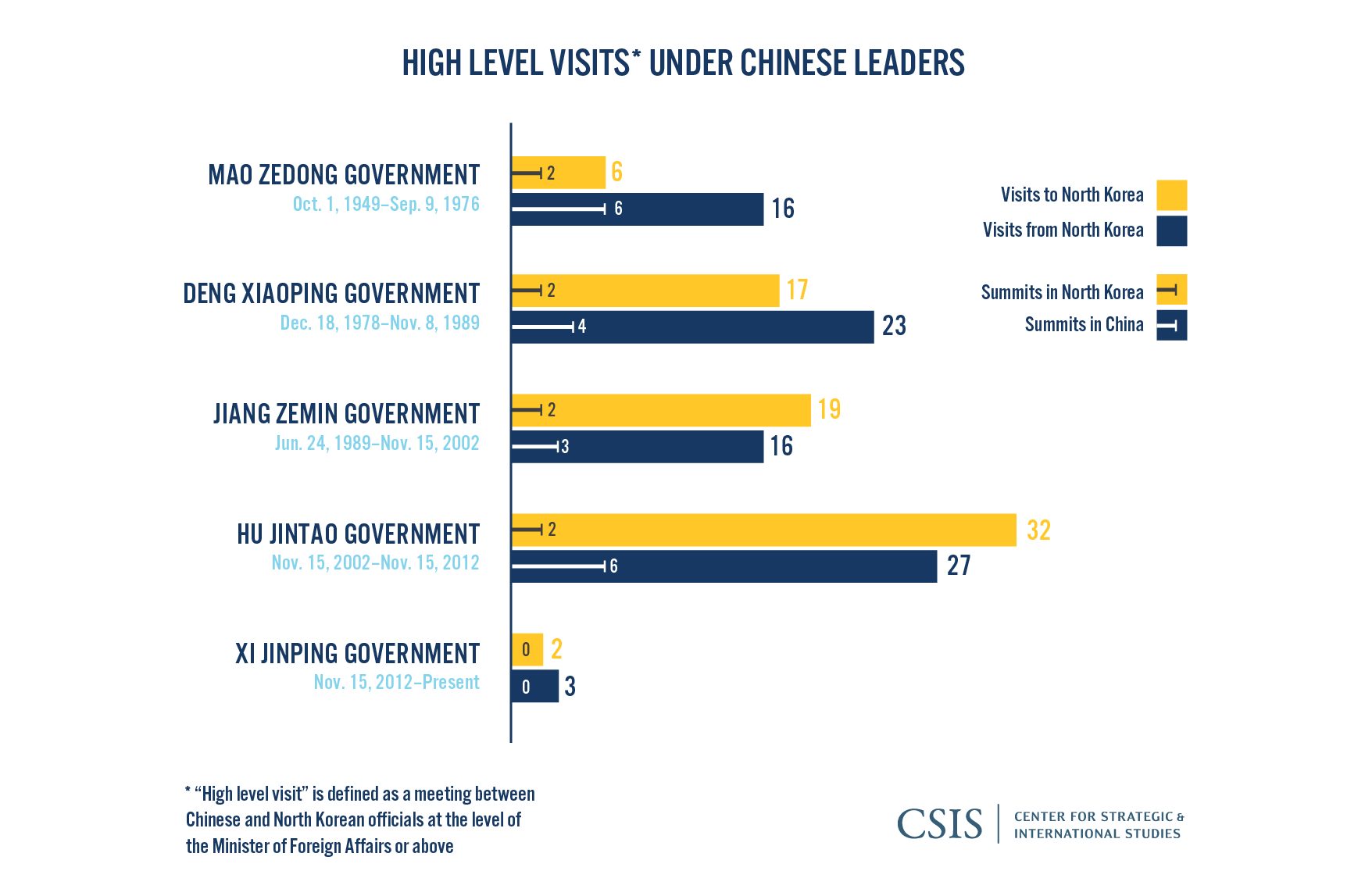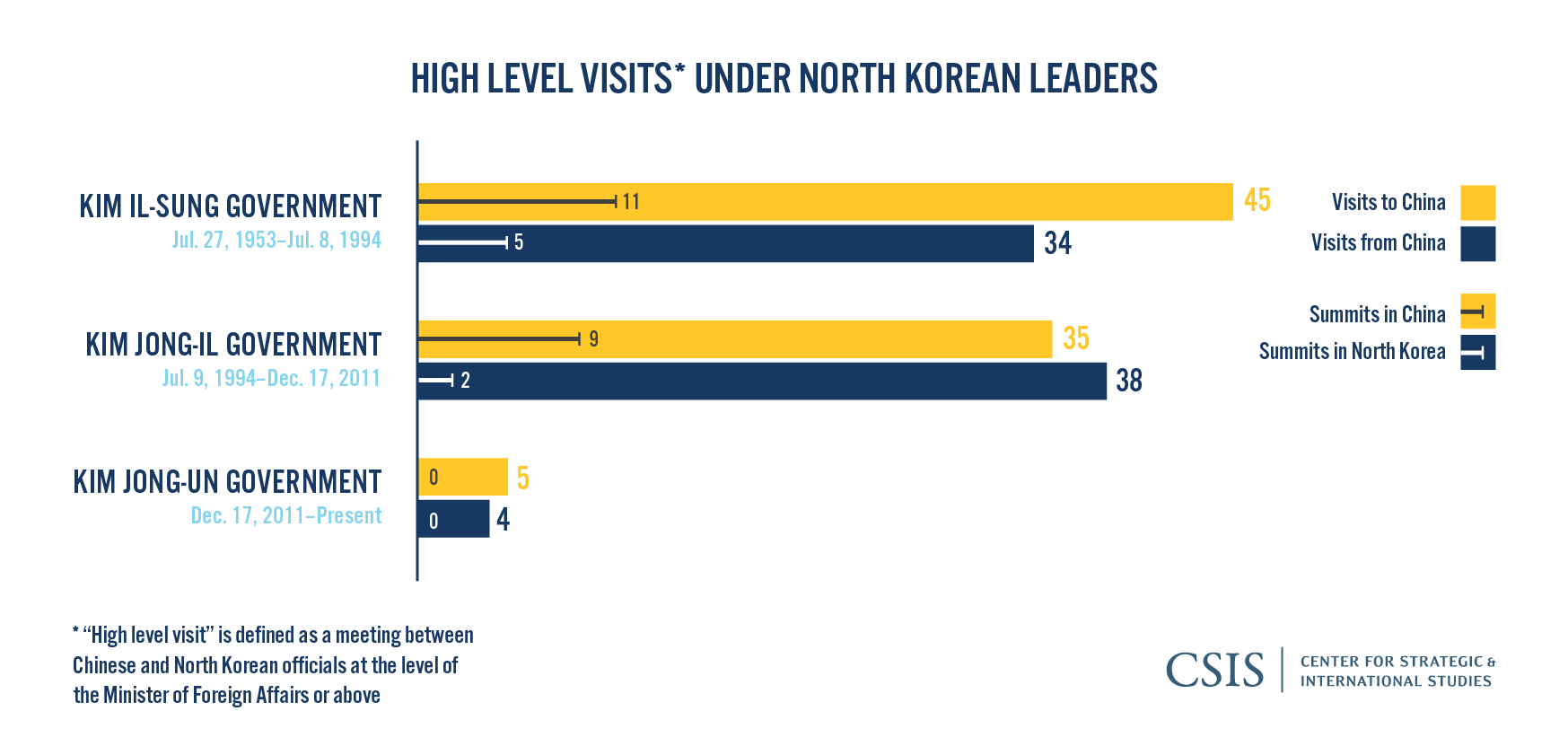Dataset: China-North Korea High Level Visits Since 1953
China and North Korea have historically been regarded as the closest of allies, a “lips and teeth” relationship forged from the battles of the Korean War and based on strong national interests. Recent events including the murder of Kim Jong-nam on February 13 in Malaysia have led some to question this close relationship. Some experts have even described the relationship as being at the lowest point in decades.
To examine the closeness of the China-North Korea relationship, Beyond Parallel created an original dataset of all high-level visits between the two countries from 1953 to the present. “High-level visit” is defined as a meeting between Chinese and North Korean officials at the level of the Minister of Foreign Affairs or above (including Head of International Liaison department). The full criteria for this definition is listed below. Our data is drawn from the official list of high-level exchanges published by the Chinese Ministry of Foreign Affairs, and supplemented by documented visits publicized in the People’s Daily and other official sources. Using this dataset, a study was conducted to determine whether the number of high level visits over the last six decades could shed light on the current state of the relationship.
Key Findings
- Since the end of the Korean War in 1953, according to open source information, there have been 167 officially documented high-level visits between Chinese and North Korean leaders.
- There has been a drop off in the average annual frequency of high-level exchanges under Kim Jong-un (1.8) and Xi Jinping (1.25), as compared with their immediate predecessors Kim Jong-il (4.29) and Hu Jintao (5.9).
- The highest frequency of visits occurred between Kim Jong-il and Hu Jintao over a nearly ten-year period. The higher frequency of visits probably reflected a strategic choice by the Chinese to increase engagement with North Korea to encourage Chinese-style economic reforms.
- The original Beyond Parallel dataset of Kim Jong-il’s summit visits to China over an eleven-year period from 2000 to 2011 supports this finding. The geographic locations of his visits and the major industrial sites that Kim Jong-il toured while in China strongly suggest a strategic plan to show the North Korean leader successful types of economic and industrial reform undertaken by China.
- The data also shows that the window of time between a North Korean nuclear test and the next high-level meeting between Chinese and North Korean officials has grown longer with each successive round of testing (5 in total).
According to the data collected by Beyond Parallel, there have been 161 officially documented high-level visits between Chinese and North Korean leaders since the end of the Korean War in 1953. The graphics above show the total number of visits held under each respective leader. There has been a noticeable drop off in the number of high-level exchanges under Kim Jong-un and Xi Jinping, as compared with their immediate predecessors Kim Jong-il and Hu Jintao. China and North Korea also have yet to hold a summit meeting between their current leaders Kim Jong-un and Xi Jinping.
Overall Frequency of High Level Visits: Chinese and North Korean Leaders
Even though Kim Jong-un and Xi Jinping have yet to hold an official summit meeting, the average frequency of China-North Korea high-level visits per year is not the lowest recorded in the history of relationship. The findings are substantiated by a comparative analysis of high-level visits under the five generations of Chinese leadership.
The average frequency of visits under each North Korean and Chinese leader is represented in the graphic below. The average annual frequency for each leader was calculated by totaling the number of visits that took place while they were in office and dividing by the total number of years that they held power.

As compared with their immediate predecessors Kim Jong-il (4.8) and Hu Jintao (5.9), Kim Jong-un (1.8) and Xi Jinping (1.25) clearly have a lower frequency of visits. However, their average numbers are not significantly different from those of Kim Il-sung (1.93), and are higher than the frequency under Mao Zedong (0.96).
To account for the fact that summit visits may hold more strategic and symbolic significance in countries like China and North Korea, we also weighted the data to see if any differences would emerge. The summit-level visits were assigned a value twice that of other high level visits (2:1) and the weighted results were calculated. Even with a weighted calculation the outcome does not change much.
The interactive below shows the relationship between the high-level visits and the ruling period of North Korean and Chinese leaders.
Visits between Chinese and North Korean Leaders
Hover on each circle to learn about each visit
The Beyond Parallel study also demonstrates that the highest frequency of visits occurred between Kim Jong-il and Hu Jintao over approximately a ten-year period. The higher frequency of visits probably reflected a strategic choice by the Chinese to increase engagement with North Korea to encourage Chinese-style economic reforms. The interactive map below shows the geographic locations of Kim Jong-il’s visits to China and the major industrial sites that he toured while there. Analysis of this information strongly suggests a strategic plan to show the North Korean leader successful types of economic and industrial reform undertaken by China.
Visits from Kim Jong-Il to China
Hover on each city to explore Kim Jong-Il’s Visits to China from 2000 – 2011
North Korean Nuclear Tests and PRC-DPRK High-Level Visits
Finally, we also looked at whether there was a correlation between North Korean nuclear tests and high-level China-DPRK visits. While the average frequency of high-level visits under Kim Jong-un and Xi Jinping is relatively low, it is also clear that the window of time between a nuclear test and the next high-level meeting between Chinese and North Korean officials has grown longer with each successive round of testing. The table below shows the increasing length of time between a North Korean nuclear test and the next high-level exchange between Chinese and North Korean officials.

Methodology
The original Beyond Parallel dataset for the high-level China-North Korea visits was compiled with the objective of creating a comprehensive open-source database of all high-level visits between the two allies since the end of the Korean War in July 1953 to the present.
Our methodology was determined by the following three things: 1) establishing the definition of a high-level visit; 2) finding sources for data collection; and 3) creating defined time-periods to be covered in the database.
Definition of High-Level Chinese and North Korean Official
The criteria for defining a high-level Chinese official that guided our research is the following:
- Head of state (including Chairman, General Secretary, Premier and Vice Premier, President and Vice President)
- Standing Committee of the Politburo (from 1956 to now)
- Chairman of the Standing Committee of the National People’s Congress (from 1954 to now)
- State Councilor (from 1982 to now)
- Minister of Foreign Affairs (from 1953 to now)
- Head of the International Liaison Department of the Chinese Communist Party (from 1953 to now).
The criteria for defining a high-level North Korean official is the following:
- Head of state
- Member of Politburo or Supreme People’s Assembly
- Cabinet-level officials
A full reference list of all officials we researched for the database can be accessed here.
Under our criteria, the recent visit by North Korean vice foreign minister Ri Kil-song to China on March 1 does not qualify as a high-level visit.
Sources for Research
The research used both primary and secondary sources. The major primary source used was the official list of high-level exchanges (中朝两国领导人重要互访一览表) compiled by the Chinese Ministry of Foreign Affairs, which was last updated in July 2015, from which 77 verified visits (both official and unofficial visits) were identified. The second primary source used was the China-North Korea bilateral relationship information page provided by the Embassy of the People’s Republic of China in the Democratic People’s Republic of Korea, which documented visits in four categories: before the 1990s, during the 1990s, from 2000-2002, 2003 – 2005, and yearly from 2006 to 2012.
The remaining 84 events among the 161 total visits were found through a variety of primary and secondary sources. These entries were all official visits. In order to find these entries, we utilized an open-source database called ZiLiaoKu (资料库), which had digitized the People’s Daily from 1946 to 2003 (accessible here). We did an advanced search from July 1953 (end of the Korean War) to December 2003 (the last digitized month of the People’s Daily available on this database) of all the officials that we know had held one of the positions in the criteria above with the word North Korea (朝鲜) within the text or title of the article. We read through every entry to verify the visit (date, location, description, and officials involved) and excluded multiple entries where an official may have been part of a delegation that had made the same trip. For those visits with multiple high-level officials attending, we only included the head of the delegation in the data entry.
Determination of Time Period
For the dataset, we covered visits starting from the end of the Korean War to the present. In that respect, our first entry was the November 1953 visit to China by Kim Il-sung, and our latest entry is the May/June 2016 trip by Ri Su-yong to China.
To determine when Chinese leaders came to power, we used the periods defined by the “Five Generations of Chinese Leadership” (五代中央领导集体).
For North Korean leaders, we determined that Kim Il-sung’s reign of power began in July 1953 and ended after his death in July 1994. (Although Kim Il-sung was the North Korean leader from 1948-1953 we excluded those dates for the purposes of this study.) Kim Jong-il’s rule was defined as the period between July 1994 and December 2011. Kim Jong-un came to power after his father’s death in 2011 and has ruled since.
For China, there is a missing two-year period between 1976 to 1978, which was excluded because of the ongoing power struggle after the death of Mao Zedong between his successor Hua Guofeng and Deng Xiaoping – there were no entries that we were able to find in that time period.
The official leadership period for Deng Xiaoping’s is also somewhat ambiguous as he never held official titles as the head of state or head of government, so we decided to use the Third Plenum of the Eleventh Central Committee of the CCP on December 18, 1978 as the start to his time as the supreme Chinese leader. We determined that was the time when he had finally fully consolidated his leadership of the CCP. The end of Deng’s reign as leader is defined by the time when he formally announced his retirement from politics during the Fifth Plenum of the Thirteenth Central Committee of the CCP on November 8, 1989.
For the three succeeding Chinese leaders (Jiang Zemin, Hu Jintao and Xi Jinping), the beginning of their time in power is defined by the date in which they were appointed as the General Secretary of the CCP. Because of this, there was an overlap of a few months (June – December) between Deng Xiaoping and Jiang Zemin, where there were two documented high-level visits. We categorized these visits under Deng, as he remained the paramount leader of China.

[carousel-horizontal-posts-content-slider-pro id='113']

